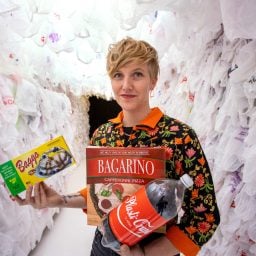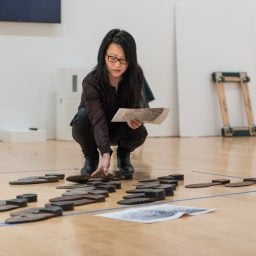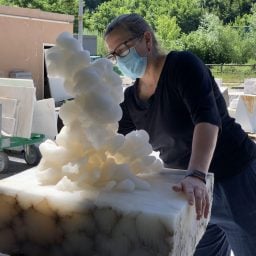Artist Aurora Robson has spent the last two decades turning trash into treasure, quite literally: Her multidisciplinary practice intercepts waste streams, transforming plastic debris into abstract sculptures and large-scale installations that meditate on the state of the environment.
She is also the founder of Project Vortex, an international collective of artists and designers focused on raising awareness around plastic pollution, shifting its trajectory, and broadening the cultural landscape through their work.
From her home studio in New York’s Hudson Valley, Robson connected with Artnet News to discuss the evolution of her practice and all things plastic—good, bad, ugly, and potentially art world–changing.
I’d love to hear a bit about the beginnings of your practice.
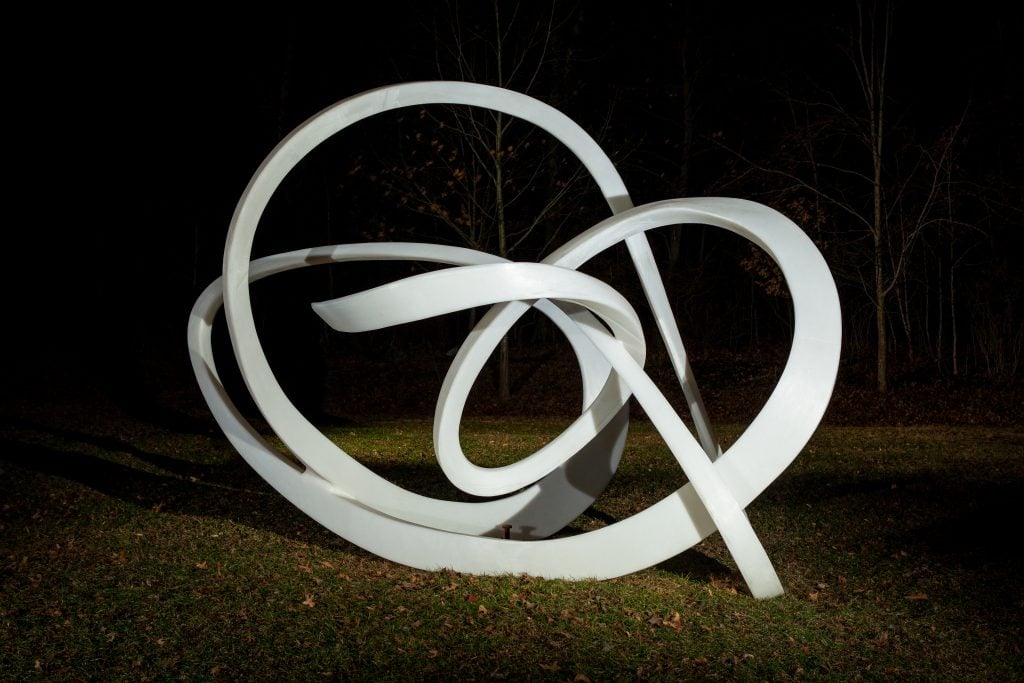
Aurora Robson, Learning Curves Night. Courtesy of the artist.
I’ve been playing this game of trash Tetris for almost 20 years now. It must’ve been 2001; I had a studio in Williamsburg. I was actually making paintings at the time—little works on paper. And I saw outside the window, on the ground, all this trash. There was a ton of it, and the sun was hitting it—all shiny bits of bottles and junk.
I noticed a correlation between the forms in the junk and the paintings I was making. And the paintings ultimately came down to this idea that I had in the very beginning of my practice, which was to take these recurring nightmares that I had when I was a little girl, and the way those nightmares presented visually, and to try to make them somehow pleasing to me.
Imagine a really, really annoying knot—just tangled mess, basically, but all curvilinear—and then these sort of gelatinous forms coming out towards you and surrounding you, so you’re trapped in it. It’s totally abstract, but referential.
I kept looking at the garbage outside my window, and was like, That’s a very similar form. You know, I [studied] sculpture in college; I never took a painting class. And I started thinking, I’ll play with that.
Why did you decide to work with plastic debris in particular?
The thing that scares me the most about plastic is how insidious it is, and how people trust it. They don’t know the chemical compositions. They don’t know how we all have phthalates in our systems—how we all have these chemicals footprints now, from plastics.
Scientists are finding microfibers in the air we breathe. And the long-term effects of this—I mean, you don’t have to be a scientist to know that’s not good. To have it in the food chain is not good; to have it in embryonic fluid is not good; to have it basically in every living [organism]—even in cellulose in plants, they’re finding trace chemicals from plastics.
There’s all kinds of waste problems, but plastic is its own animal—it’s in its own category of destructiveness. So that’s been my focus. [I wanted to] see if I could do the same thing [as I did in my paintings]—but with this global nightmare, instead of just with my personal nightmare.
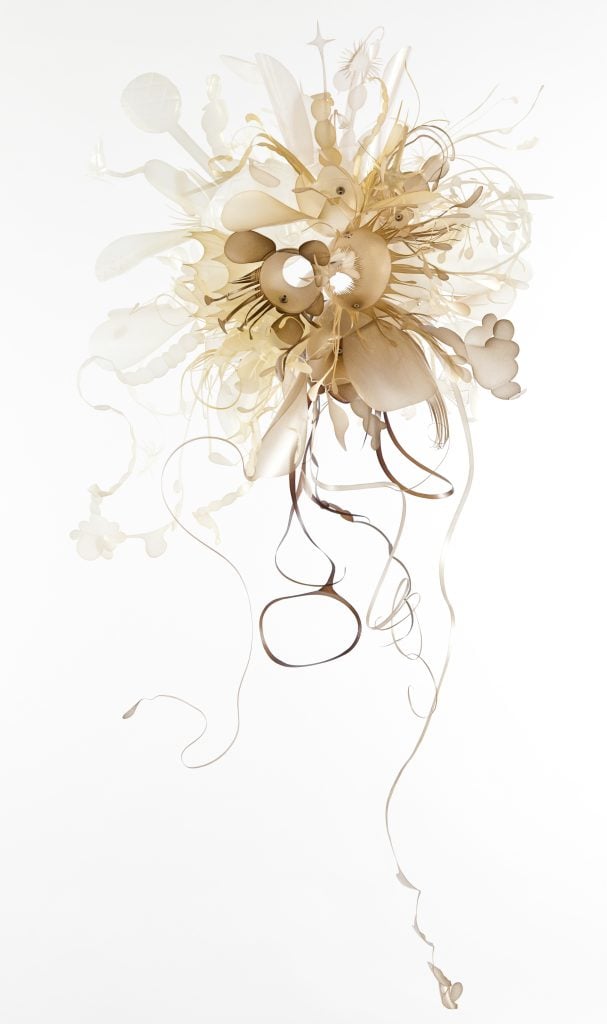
Aurora Robson, Madhu. Courtesy of the artist.
What is the potential of plastic debris as a raw material, and how have you been experimenting with it in your work?
I really just responded to it initially from a strictly conceptual angle. I was interested in the familiar aspect of it, as a material. You know, people think of it as disposable, but it’s exactly the opposite. I felt it was odd that it wasn’t being explored in contemporary art in New York City—I saw nothing in the galleries or museums. It was exclusively on the street.
And so I thought, well, that’s weird, because the best art, in my opinion, has always been [made from] realia—you’re reflecting a shared reality and trying to filter it through your consciousness and present it in a way that can support dialogue or reflection or engagement.
I love plastic debris for art and design, and what you can do with it. I’ve been ultrasonic welding it, I’ve been injection welding it, I’ve been riveting it, I’ve been threading it, I’ve been sewing it.
I’ve been compulsively exploring the material to see if there are ways I can develop it for not just my own studio practice, but in a way that would also be adaptable for other people to utilize this material, and keep it out of the highly dysfunctional recycling process. Only really about nine percent of plastic, globally, actually gets recycled.
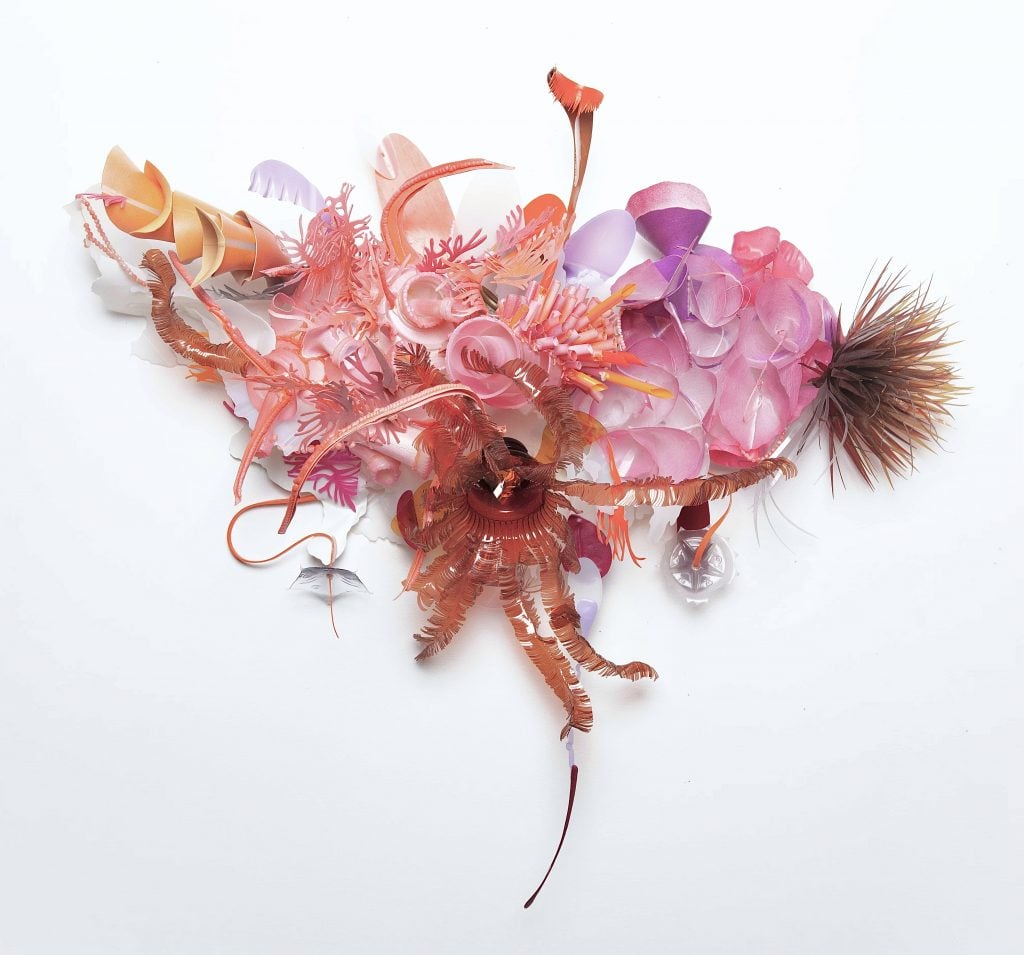
Aurora Robson, A Fine Romance. Courtesy of the artist.
Yikes. Really?
Lately, the estimates are even a little bit lower.
I’m doing a talk next month [about] the art of conservation with the plastics head of the World Wildlife Fund. We’ve been sending back and forth statistics, and it’s so depressing. It’s unbelievable how dysfunctional our waste management [system is], and what we’ve been doing as a species to ourselves. The thing that keeps me going is that I see potential in the material for art applications that isn’t being explored, that isn’t being taught.
That’s what you’re doing with Project Vortex. How did it get started?
Project Vortex started around 2009, 2010. I went to Hawaii for a month and worked with the Hawaii Wildlife Fund. They do coastal cleanups on the southernmost tip of a Big Island—the Waimea Ocean Film Festival director had invited me to come make a piece working with material they collected. They set me up with a team of really amazing high school students who were enthusiastically giving up their Christmas break to help me clean and sort through material and make this piece. And I was like, Wow, I have to do something more than just make a piece of art out of plastic garbage.
Also, seeing the tonnage of ocean plastic firsthand and recognizing how far it was traveling, it really hit me—I needed to do something more. And I also felt like I needed to develop more of a community around this, because from working for that amount of time with it, I was starting to feel really depressed. It was like, This is just like David and Goliath.
That was the impetus. I started just reaching out to other artists who were doing interesting things with plastic debris, thinking, Can we develop a collective around this? I think in systems, and in terms of creating models that could be adapted and manipulated by others to suit their parameters. And I’m forever striving to be of better service. So one of the Project Vortexers will be like, “I really need pen caps!” And I’m like, “All right.”
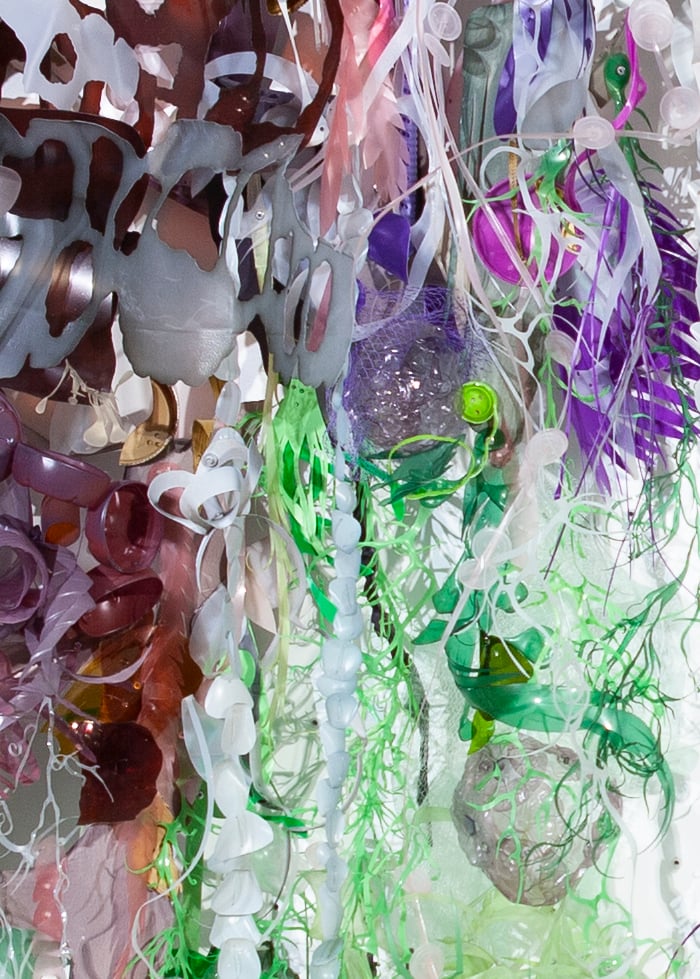
Aurora Robson, Carey details. Courtesy of the artist.
What are your goals for the project, and where do things stand?
One is educational engagement and trying to get academic implementation of curricula or courses that integrate methods and skills that the artists have been developing to work with plastic debris—because some of it is on par with metal sculpture, and it’s not extractive. You can also localize your raw material, which is amazing.
And you know, it sort of eliminates this blank canvas syndrome, where art school students freak out and are like, “Oh, I don’t want to make it worse!” You can’t make plastic garbage worse than it is! So it’s very liberating for young students and artists.
Then there’s the aspect of broadening and diversifying the cultural landscape and having it be more inclusive, not just in terms of people, but also in terms of material. Why is it that art education still has so much emphasis on traditional materials or high-tech materials, and nobody is paying attention to plastic debris? Meanwhile, it has archival integrity built into it. It’s everywhere, and it’s free. And all communities have access to it.
A lot of it was really gaining momentum before [2020] hit. We were supposed to have our first major exhibition at the School of Visual Arts gallery with works by Project Vortex artists that were within a certain radius of New York City.
In terms of your own practice, how do you actually go about intercepting the plastic waste stream? Are you just constantly collecting and sorting through it?
Yeah, pretty much. I’m like this crazy lunatic with a lot of plastic garbage everywhere. I have a shipping container [outside my home studio] with hundreds of thousands of bottle caps that I’ve sorted and themed, and it’s organized by color. My daughters are like, “You’re so trashy, mom.”
But I try to use every piece of plastic that comes into my house in my work, which is really hard with two daughters—you have birthday parties, and other parents buying presents for your children, and then the next thing you know, you’ve got a mountain of Barbie dolls.
People send me their stuff, too. I get bottle caps from Japan, people sending me their stuff that they don’t want.
Which kind of detracts from your practice, no?
I know! I mean, that’s not good, to be shipping plastic garbage around.
But on the plus side, that means your work is engaging people and raising awareness.
If they’re aware that nine percent or less is actually getting recycled, then any sequestering that’s possible is better. Right?
But then there’s the carbon footprint, of course. It’s like, Aargh.
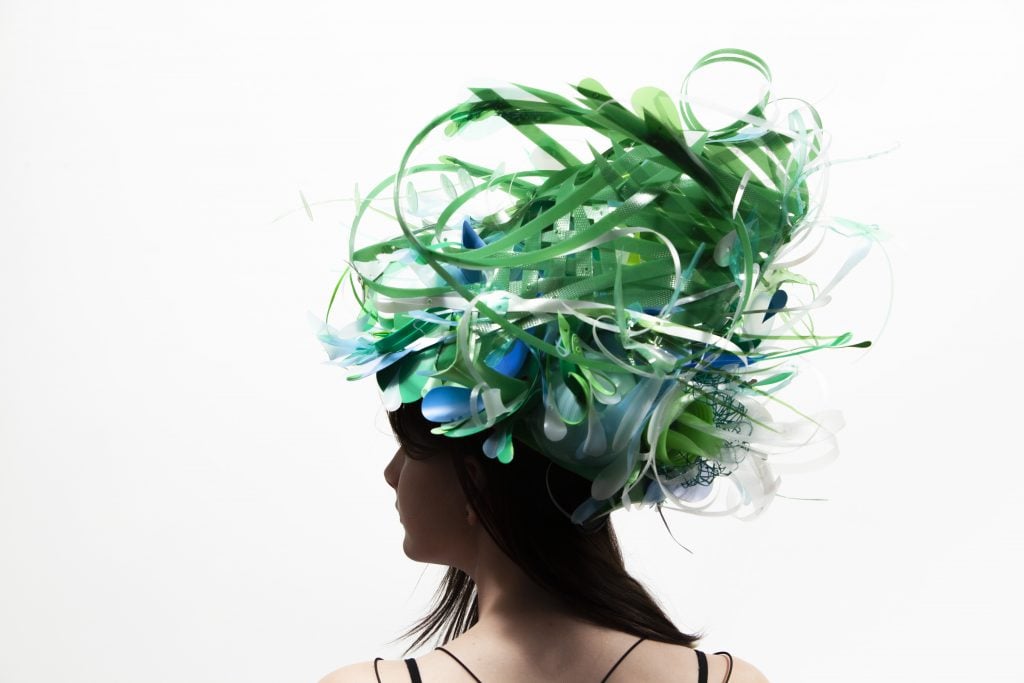
Aurora Robson, Plantpocalypse. Courtesy of the artist.
What are you working on now?
I’m at a moment of evolution in my own practice.
I’ve been starting to do wearable things, [like a headpiece from] a construction helmet that my husband found on the side of the road—my daughter Isla named it Plantpocalypse. I plan to include them in a solo show I have opening in June 2023 at the Brattleboro Museum [in Vermont], “Human Nature Walk”. It’s a year-long exhibition with a large, site-specific installation mixing all of the techniques that I’ve developed—sort of like the left and right sides of the brain coming together in nature.
I’m also working on my first large-scale-ish permanent outdoor public piece for Amazon’s new corporate headquarters in Arlington, Virginia, which will be unveiled in April 2023. It’s using a Filabot—a whole recycling system, basically, where you can take plastic debris, and put it into this machine that turns it into filament.
So I’ll be going from hand-manipulating plastic debris to creating my own filament from scraps that I’ve been saving for 18 years. And the filament can be used either to weld, with my injection welder, or with a 3D printer.
I just placed an order for a high-resolution scanner so that I can start scanning [and then 3D print] certain types of mushrooms.
Mushrooms?
Yes. I’m deep in mushrooms right now. I have been starting to grow them. I’m a member of the Mycological Association in the Hudson Valley. I’m such a dork.
Do you know that there are two types of mushrooms that ingest plastic?
I didn’t! That sounds unreal.
One of them—the pestalotiopsis microspora—my friend is cultivating in her apartment in Brooklyn. They eat polymers, and we can then we eat them, and they’re healthy, too—a very good source of protein! It’s amazing.
I love the idea of mushrooms eating plastic—maybe there’s hope for us. That’s how I think of my process, basically—I’m like a glorified janitor, just cleaning up all the messes and trying to make them nice.








